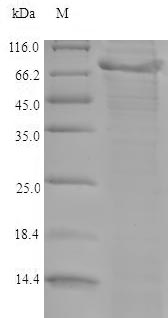The Recombinant Mouse Adamts5 protein comes from E.coli expression and covers amino acids 262 to 930, representing the complete mature protein sequence. An N-terminal 6xHis tag gets attached during production, which makes purification and detection much simpler. SDS-PAGE analysis shows the protein reaches over 90% purity - a solid standard for most research work. This product is strictly for research purposes and shouldn't be used for any therapeutic or diagnostic applications.
Adamts5 belongs to the ADAMTS protein family and plays a key role outside cells by breaking down aggrecan, one of cartilage's main building blocks. The protein appears to help control how the extracellular matrix gets remodeled, making it particularly interesting for cartilage studies. Many researchers focus on Adamts5 when they want to understand tissue development and disease, especially in musculoskeletal contexts.
Potential Applications
Note: The applications listed below are based on what we know about this protein's biological functions, published research, and experience from experts in the field. However, we haven't fully tested all of these applications ourselves yet. We'd recommend running some preliminary tests first to make sure they work for your specific research goals.
Based on the provided information, the recombinant mouse ADAMTS5 is expressed in E. coli, a prokaryotic system that is generally unsuitable for producing functional eukaryotic metalloproteinases like ADAMTS5. ADAMTS5 is a complex multi-domain protein requiring precise folding, disulfide bond formation, glycosylation, and propeptide processing for its proteolytic activity. The expressed fragment (262-930aa) represents a partial sequence of the mature protein, lacking the prodomain and potentially other regulatory regions, with an N-terminal 6xHis tag that may interfere with native structure. E. coli lacks the eukaryotic chaperones, disulfide isomerases, and post-translational modification machinery necessary for the correct folding of such a complex protein. Since activity is unverified, the protein cannot be assumed to be correctly folded or bioactive without experimental validation of its metalloproteinase activity and structural integrity.
1. Protein-Protein Interaction Studies Using His-Tag Pull-Down Assays
The N-terminal 6xHis tag enables technical feasibility for pull-down assays. However, if ADAMTS5 is misfolded (as likely in E. coli), it will not interact physiologically with true binding partners (e.g., extracellular matrix components or inhibitors). Metalloproteinases require precise conformation for specific interactions. Identified interactions could be non-physiological artifacts. This application should not be pursued without confirmation of proper folding and proteolytic activity.
2. Antibody Development and Validation
The recombinant ADAMTS5 fragment can serve as an effective immunogen for generating antibodies that recognize linear epitopes within the 262-930aa region, even if the protein is misfolded. The high purity supports immunization protocols. However, antibodies may not recognize conformational or glycosylation-dependent epitopes of native, properly folded ADAMTS5 in mouse tissues. Validation against endogenous ADAMTS5 is essential.
3. Biochemical Characterization and Protein Stability Studies
This application is well-suited for assessing the recombinant mouse ADAMTS5 itself. Techniques like size-exclusion chromatography, circular dichroism spectroscopy, and thermal shift assays can evaluate the protein's folding state, oligomerization, and stability. These studies are valuable even if the protein is inactive, as they characterize the recombinant product and can inform about its suitability for other applications.
4. Substrate Specificity Screening Assays
This application is highly problematic without activity verification. If ADAMTS5 is misfolded, substrate screening assays will not reflect biological specificity. Metalloproteinases require precise active site conformation and zinc coordination for proteolytic activity. This application requires prior demonstration of proper folding and proteolytic activity using known substrates (e.g., aggrecan or versican).
Final Recommendation & Action Plan
Given the high probability of misfolding in E. coli for this complex metalloproteinase, recommend first performing comprehensive validation: 1) Functional validation using proteolytic activity assays with known substrates (e.g., fluorescent peptide substrates or natural ECM components); 2) Biophysical characterization (circular dichroism for secondary structure, analytical ultracentrifugation for oligomeric state) to assess folding quality; 3) If possible, comparison with ADAMTS5 from mammalian expression systems. Antibody development and biochemical characterization can proceed as the safest applications. Avoid all functional studies (interactions, substrate screening) until proper folding and activity are confirmed. For reliable ADAMTS5 research, obtain the protein from eukaryotic expression systems capable of proper folding and post-translational modifications. Always include appropriate controls such as active enzyme standards and known substrates in experiments.






